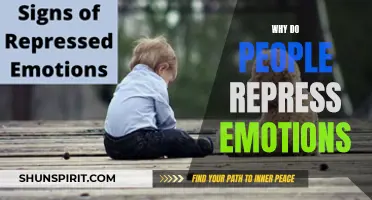
Emotional abuse is a complex and insidious form of mistreatment that can wreak havoc on a person's mental and emotional well-being. Unlike physical abuse, which often leaves visible marks or bruises, emotional abuse can be challenging to detect. It operates silently behind closed doors, leaving its victims feeling trapped and powerless. The subtle manipulation, gaslighting, and constant criticism employed by emotional abusers make it difficult for outsiders to recognize the signs and for victims to even acknowledge their own pain. In this essay, we will explore the various reasons why emotional abuse is so hard to detect, shedding light on the importance of awareness and support for its victims.
| Characteristics | Values |
|---|---|
| Subtle and covert | Emotional abuse is often not overt or obvious, making it difficult for victims to recognize and identify the behavior as abusive. |
| Psychological manipulation | Emotional abusers are skilled at manipulating the emotions and thoughts of their victims, making it hard for them to understand what is happening to them. |
| Gradual erosion | Emotional abuse typically occurs over a long period of time, with the abuser slowly chipping away at the victim's self-esteem and self-worth. This gradual erosion can be hard to notice until significant damage has already been done. |
| Blaming and gaslighting | Emotional abusers often place the blame on the victim, making them question their own reality and sanity. This gaslighting technique further confuses and disorients the victim. |
| Lack of physical evidence | Unlike physical abuse, emotional abuse does not leave visible marks or bruises, making it harder to prove and detect. |
| Isolation and control | Emotional abusers often isolate their victims from family and friends, creating a sense of dependency and making it harder for the victim to seek help or escape the abusive situation. |
| Fear and intimidation | Emotional abusers use fear and intimidation tactics to control and manipulate their victims. This fear can prevent victims from speaking out or seeking help. |
| Internalized blame and shame | Victims of emotional abuse often internalize the blame and shame, believing that they deserve the mistreatment or that they are somehow responsible for the abuser's actions. This self-blame can make it harder for them to recognize the abuse and seek help. |
What You'll Learn
- What are the main characteristics or behaviors that make emotional abuse difficult to detect?
- How does emotional abuse differ from physical abuse, and why is it often more challenging to identify and address?
- What are some common signs or red flags that indicate emotional abuse is taking place in a relationship or situation?
- How does emotional abuse impact the mental health and well-being of the victim, and why is it important to recognize and address this form of abuse?
- What can individuals and society do to better support survivors of emotional abuse and create a safer environment for detection and prevention?

What are the main characteristics or behaviors that make emotional abuse difficult to detect?
Emotional abuse is a form of psychological manipulation that can cause significant harm to an individual's mental and emotional well-being. Unlike physical abuse, emotional abuse often does not leave visible marks or scars, making it much more challenging to detect. There are several main characteristics and behaviors that make emotional abuse difficult to identify or recognize. By understanding these traits, individuals can become better equipped to recognize and address emotional abuse when it occurs.
One of the main characteristics of emotional abuse that makes it difficult to detect is that it often occurs within the confines of a close relationship, such as a romantic partnership or family dynamic. The abuser may be someone the victim trusts implicitly, making it harder for them to recognize the behavior as abusive. Additionally, emotional abuse often occurs gradually over time, with the abuser employing various subtle tactics to control and manipulate their victim. This slow progression can make it harder for individuals to notice that they are being emotionally abused.
Another characteristic of emotional abuse is that it often involves verbal rather than physical actions. The abuser may use words to belittle, demean, or degrade their victim, eroding their self-esteem and sense of self-worth. These verbal attacks can be subtle and may involve gaslighting, where the abuser manipulates the victim's perception of reality, making them question their own thoughts and feelings. As there are no visible signs of physical harm, it can be challenging for the victim to recognize that they are being emotionally abused.
Emotional abuse also tends to be insidious in nature, with the abuser strategically targeting the victim's vulnerabilities and insecurities. They may exploit the victim's fears or weaknesses, using them as ammunition to manipulate and control. These tactics can make the victim feel emotionally trapped and dependent on the abuser, further hindering their ability to recognize the abuse.
Furthermore, emotional abuse often involves isolation and control. The abuser may try to cut off the victim from their support system, such as friends or family, making it harder for the victim to seek help or escape the abuse. By controlling who the victim can interact with or speak to, the abuser maintains power and control over the victim's emotions and actions.
Lastly, emotional abuse can be difficult to detect due to societal misconceptions and stigmas surrounding abuse. Many people associate abuse only with physical violence, leading to a lack of awareness and understanding of emotional abuse. Victims may downplay their experiences or blame themselves, believing that the abuse is their fault. This self-blame and societal denial can further contribute to the difficulty in identifying emotional abuse.
Recognizing emotional abuse can be a challenging process, but there are steps individuals can take to protect themselves or others. Educating oneself about the signs and characteristics of emotional abuse is crucial. It is essential to trust one's instincts and seek support from trusted friends, family, or professionals if abuse is suspected. Creating awareness and open conversations about emotional abuse can help reduce the stigma and misconceptions surrounding this form of abuse, making it easier for victims to come forward and seek help.
In conclusion, emotional abuse is a form of psychological manipulation that often goes unnoticed or unrecognized due to several main characteristics and behaviors. These include the close relationship between the abuser and the victim, the gradual nature of the abuse, the reliance on verbal attacks and manipulation, the targeting of vulnerabilities and insecurities, the isolation and control, and the societal misconceptions surrounding abuse. By understanding these traits, individuals can better identify and address emotional abuse, creating safer and healthier environments for all.
Understanding the Role of Intent in Emotional Abuse: Does it Have to be Deliberate?
You may want to see also

How does emotional abuse differ from physical abuse, and why is it often more challenging to identify and address?
Emotional abuse, also known as psychological abuse, is a form of abuse that does not leave physical marks, but can have long-lasting effects on a person's mental and emotional well-being. It is often more challenging to identify and address emotional abuse compared to physical abuse due to its subtle nature and the lack of visible signs.
First and foremost, it is important to understand the key differences between emotional abuse and physical abuse. Physical abuse involves the use of force, such as hitting, kicking, or restraining, which can result in visible injuries. On the other hand, emotional abuse involves the manipulation, belittlement, and control of a person's thoughts, feelings, and actions. Emotional abuse can take many forms, including constant criticism, humiliation, control, isolation, threats, and intimidation. While physical abuse can be easier to recognize due to its visible signs, emotional abuse is often more insidious and can go unnoticed for extended periods of time.
One reason why emotional abuse is more challenging to identify is that it does not leave visible scars or bruises, making it difficult for outsiders to recognize and intervene. Victims of emotional abuse may appear perfectly fine on the outside, but they may be suffering silently on the inside. They may exhibit symptoms such as low self-esteem, anxiety, depression, and a sense of worthlessness. However, these symptoms can be attributed to a variety of other factors, making it easier for the abuse to go unnoticed or be brushed off as something else.
Furthermore, emotional abuse often occurs behind closed doors, making it difficult for others to witness and validate the victim's experiences. The abuser may present a completely different persona to the outside world, while subjecting their victim to constant emotional pain and turmoil in private. This can create a sense of isolation for the victim, as they may feel like no one will believe or understand their experiences. The abuser may also manipulate the victim into believing that the abuse is their fault, further perpetuating the cycle of abuse.
Addressing emotional abuse can be challenging due to a variety of factors. Victims may be in denial about the abuse, or they may be too scared to speak out due to fear of retaliation or further abuse. The constant manipulation and control by the abuser can leave the victim feeling helpless and trapped. Additionally, emotional abuse can take a toll on a person's self-esteem, making it even more difficult for them to seek help or leave the abusive relationship.
However, it is crucial to address emotional abuse and provide support for the victims. One way to do so is by creating awareness and education about emotional abuse and its consequences. This can help victims to recognize the signs of emotional abuse and seek help when needed. Support groups and therapy can also be beneficial in providing a safe space for victims to share their experiences, gain validation and support, and develop coping strategies.
In conclusion, emotional abuse is a form of abuse that can be more challenging to identify and address compared to physical abuse due to its subtle nature and the lack of visible signs. It is important to create awareness about emotional abuse and provide support for victims to empower them to speak out and seek help. By addressing emotional abuse, we can work towards creating a society that values and respects the mental and emotional well-being of all individuals.
The Silent Torture: When Lack of Affection Becomes Emotional Abuse
You may want to see also

What are some common signs or red flags that indicate emotional abuse is taking place in a relationship or situation?
Emotional abuse is a form of abuse that can be just as damaging as physical abuse, yet it often goes unnoticed or unrecognized. Unlike physical abuse, emotional abuse does not leave visible scars, making it harder to detect. However, there are several signs or red flags that indicate emotional abuse may be taking place in a relationship or situation. It is crucial to be aware of these signs in order to protect oneself or support someone who may be experiencing emotional abuse.
One common sign of emotional abuse is a consistent pattern of belittling or demeaning behavior. This can include name-calling, constant criticism, and the use of derogatory language. The abuser may often make negative comments about the victim's appearance, intelligence, or abilities, which can wear down their self-esteem and confidence over time.
Another sign of emotional abuse is controlling or manipulative behavior. The abuser may exert control over every aspect of the victim's life, such as what they wear, who they can see, and where they can go. They may isolate the victim from friends and family, creating a sense of dependency on the abuser. Manipulation tactics, such as guilt-tripping or gaslighting, are also common in emotionally abusive relationships.
Emotional abuse often involves threats or intimidation. The abuser may use threats of violence, harm, or even suicide to control the victim's behavior or keep them trapped in the relationship. They may also display intimidating behaviors such as yelling, breaking objects, or displaying aggressive body language. These tactics create an atmosphere of fear and can make the victim feel trapped and powerless.
Isolation is another red flag that often accompanies emotional abuse. The abuser may discourage or forbid the victim from socializing with friends or family, making them feel alone and isolated. This isolation makes it easier for the abuser to maintain control and can contribute to the victim's feelings of helplessness and dependency.
Emotional abuse can also involve constant monitoring or surveillance. The abuser may invade the victim's privacy by constantly checking their phone, email, or social media accounts. They may demand constant updates on the victim's whereabouts or use tracking devices to monitor their movements. This invasion of privacy serves to further control the victim and erode their sense of autonomy.
In some cases, emotional abuse can escalate into physical abuse. It is important to recognize the signs early on and seek help before it reaches this point. If you or someone you know is experiencing emotional abuse, it is crucial to reach out for support. Talk to a trusted friend, family member, or counselor who can provide guidance and resources.
In conclusion, emotional abuse is a serious issue that can have severe consequences for the victim's mental and emotional well-being. It is important to educate oneself about the signs and red flags of emotional abuse in order to recognize it and take action. By being aware of these signs, we can work towards creating healthier relationships and preventing further harm.
Understanding the Emotional Abuse Behind an Affair
You may want to see also

How does emotional abuse impact the mental health and well-being of the victim, and why is it important to recognize and address this form of abuse?
Emotional abuse is a form of abuse that can have devastating effects on the mental health and well-being of the victim. It is a covert form of abuse that typically involves controlling and manipulative behavior, such as constant criticism, belittling, humiliation, and invalidation. The effects of emotional abuse can be long-lasting and can affect all aspects of a person's life, including their self-esteem, relationships, and overall happiness.
One of the most significant impacts of emotional abuse is the erosion of the victim's self-esteem. Constant criticism and belittling slowly chip away at a person's self-confidence, leaving them feeling worthless and inadequate. Over time, the victim may begin to internalize these negative messages and believe that they are indeed deserving of the abuse. This can lead to a cycle of self-blame and self-doubt, making it even more challenging to break free from the abusive relationship.
Emotional abuse also affects the victim's mental health. The constant stress and anxiety caused by the abuse can lead to symptoms such as depression, anxiety disorders, and even post-traumatic stress disorder (PTSD). Victims of emotional abuse often live in a constant state of fear, anticipating the next outburst or attack. This chronic stress can have a significant impact on the body and can lead to physical health problems as well.
In addition to the direct impact on the victim's mental health, emotional abuse can also have long-term effects on their ability to form healthy relationships. Victims may struggle with trust issues, have difficulty setting boundaries, and may even repeat patterns of abuse in their future relationships. This perpetuates the cycle of abuse and makes it even more challenging for the victim to break free and heal.
Recognizing and addressing emotional abuse is crucial for several reasons. Firstly, emotional abuse is often subtle and can go unnoticed by outsiders. By raising awareness and understanding of the signs and effects of emotional abuse, we can help victims recognize their situation and seek help. Early intervention is key in breaking free from the cycle of abuse and preventing further harm.
Secondly, addressing emotional abuse is essential for the long-term well-being of the victim. By providing support and resources, we can help victims heal from the trauma they have experienced and rebuild their self-esteem and confidence. Therapy and support groups can be instrumental in helping survivors of emotional abuse process their experiences and learn healthy coping mechanisms.
Finally, recognizing and addressing emotional abuse is crucial for stopping the cycle of abuse. Many abusers were once victims themselves and may not even be fully aware of the harm they are causing. By addressing emotional abuse, we can help both the victim and the abuser break free from destructive patterns and learn healthy ways of relating to others.
In conclusion, emotional abuse has a profound impact on the mental health and well-being of the victim. It erodes their self-esteem, affects their mental health, and can have long-term effects on their ability to form healthy relationships. It is crucial to recognize and address emotional abuse to help victims seek help, heal from the trauma, and break free from the cycle of abuse. By providing support and resources, we can empower survivors to reclaim their lives and build a happier, healthier future.
Understanding the Process of Emotional Abuse Lawsuits: How They Work and What to Expect
You may want to see also

What can individuals and society do to better support survivors of emotional abuse and create a safer environment for detection and prevention?
Emotional abuse is a form of mistreatment that can have long-lasting effects on survivors. It involves the use of words, actions, or behaviors to control, manipulate, or degrade the victim. The effects of emotional abuse can be just as damaging as physical abuse and can lead to a variety of mental health issues, including anxiety, depression, and low self-esteem. It is crucial for individuals and society as a whole to support survivors of emotional abuse and create a safer environment for detection and prevention. Here are some steps that can be taken to achieve these goals:
- Education and awareness: One of the first steps in creating a safer environment for survivors of emotional abuse is education and awareness. This includes educating individuals about what emotional abuse is, how to recognize it, and the effects it can have on survivors. It also involves raising awareness about the importance of supporting survivors and the resources that are available to help them.
- Listening and validation: One of the most important things that individuals can do to support survivors of emotional abuse is to listen to them and validate their experiences. Survivors often feel isolated and ashamed, so it is important to create a safe and non-judgmental space for them to share their feelings and experiences. This can help survivors feel heard and understood, and can also help them begin to heal.
- Offering resources and support: There are many resources available to survivors of emotional abuse, including hotlines, support groups, and counseling services. Individuals can help by providing survivors with information about these resources and offering support in accessing them. This can include helping survivors make phone calls, accompanying them to counseling sessions, or simply being there to listen and offer a shoulder to lean on.
- Holding abusers accountable: In addition to supporting survivors, it is crucial to hold abusers accountable for their actions. This includes reporting incidents of emotional abuse to the appropriate authorities and supporting survivors in seeking legal action if necessary. It also involves challenging societal attitudes and beliefs that perpetuate emotional abuse, such as victim-blaming or minimizing its severity.
- Promoting healthy relationships and communication: Prevention is an important aspect of creating a safer environment for all individuals. By promoting healthy relationships and communication, we can help prevent emotional abuse from occurring in the first place. This includes teaching children and young adults about healthy boundaries, consent, and effective communication skills. It also involves challenging societal norms that perpetuate unhealthy relationship dynamics, such as traditional gender roles or the belief that power and control are necessary components of relationships.
In conclusion, supporting survivors of emotional abuse and creating a safer environment for detection and prevention requires both individual and societal action. By educating ourselves about emotional abuse, listening to and validating survivors' experiences, offering resources and support, holding abusers accountable, and promoting healthy relationships and communication, we can make a difference in the lives of survivors and work towards a future free from emotional abuse. Together, we can create a society that values empathy, respect, and equality.
The Power Dynamics of Easily Forgiving: Unveiling Emotional Abuse
You may want to see also
Frequently asked questions
Emotional abuse is hard to detect because it does not leave physical scars or evidence like other forms of abuse. Instead, it is a pattern of behaviors that can be subtle and go unnoticed by others. The abuser may use manipulation, gaslighting, and other tactics to undermine the victim's self-esteem and make them doubt their own perceptions.
Emotional abuse can have a profound impact on the victim's mental and emotional well-being. It can erode their self-confidence, create feelings of worthlessness, and lead to anxiety and depression. The constant belittling, criticism, and controlling behavior can leave lasting emotional scars that are not easily visible to others.
Victims of emotional abuse often stay in the relationship due to several reasons. They may have low self-esteem and believe that they deserve the abuse or that they cannot find someone else who will love them. The abuser may also use manipulation and control tactics to make the victim feel dependent on them, further trapping them in the abusive relationship.
If you suspect someone may be experiencing emotional abuse, it is important to approach the situation with empathy and support. Let the person know that you are there for them and believe them. Encourage them to seek professional help, such as therapy or counseling, and provide resources for local domestic violence hotlines or shelters. However, it is crucial to respect their autonomy and not pressure them to leave the relationship before they are ready, as leaving an abusive relationship can be a highly complex and dangerous process.







